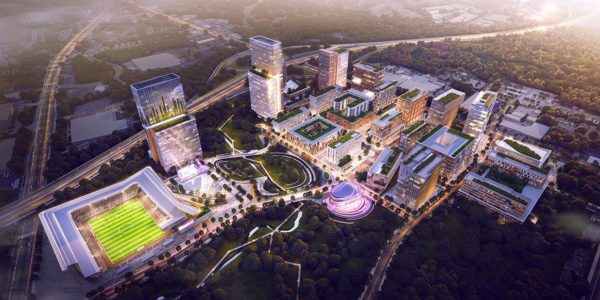Q: What’s our take on Kane Realty’s plan for a soccer stadium/”entertainment venue” in his Downtown South project?
A: It’s a bad idea, especially when you remember that South Wilmington Street is supposed to be a corridor for Bus Rapid Transit — and affordable housing.
-
Kane Realty can build/develop anything he wants. The wide-open rezoning for his property approved by City Council allows developer John Kane total discretion about what will go up in DTS. That said, if he wants a stadium, he should build it on his own dime. But, it seems, he doesn’t want it that much. He only wants it if the taxpayers will pay him to build it, to the tune of $200 million to $300 million. That’s what this whole “Tax Increment Grant” controversy is all about. Kane’s asking for a “TIG” worth some $450 million, but take the stadium off the table — or leave it there and make Kane pay for the stadium if he wants it — and no TIG is needed.

Kane’s stadium location is at the intersection of South Wilmington St. (left) and the I-40 Beltline. This rendering, supplied by Kane Realty, is a view from the northeast.
-
Affordable housing, presumably mixed with market-rate housing, would be a far better use of the site that Kane’s targeted for his stadium. The location fronts on South Wilmington Street, a future Bus Rapid Transit corridor. A BRT station stop is planned for this exact spot on South Wilmington Street. Affordable housing — apartments that people with low incomes can afford — is not just the best use of the site, it’s the use Raleigh’s been promising ever since the BRT idea surfaced 15 years ago.
-
And guess what? No TIG is needed to finance affordable housing there, or anywhere. Why? Because the city included money in the $80 million Affordable Housing bond issue last year precisely for the purpose of acquiring land along the BRT corridors. That’s in addition to existing city and county programs available to subsidize affordable housing units, plus the federal program of Low-Income Housing Tax Credits (LIHTC), which typically pays about 40% of the cost of AH construction.
-
To repeat, no TIG is needed to pay for affordable housing if Kane wants to include it in DTS. When his spokesman, Bonner Gaylord, mixes his pitch for the TIG with promises of affordable housing — as if funding for AH is somehow dependent on funding the stadium too — he is either mistaken or he’s misleading us.
**
About that Stadium:
Let’s give Bonner Gaylord some credit. In his relentless push for the stadium, he’s been very clear why Kane Realty wants it. They want it to anchor a retail center with an entertainment component, but not the old movieplex, like Kane has at North Hills. In the 21st century, developers are building malls and hotels attached to outdoor venues outfitted with giant screens and movable stages, suitable as much for concerts and shows as for games.
A stadium attached to their project would be the “draw” — Gaylord’s word — to bring customers to DTS from across Raleigh and the Triangle. Customers who would shop there. Customers who would live there, in the glittering high-rise housing that Kane plans. Or work there, in the glittering high-rise office space that Kane plans.
DTS is not intended to benefit the surrounding communities of Southwest and Southeast Raleigh. It is intended to serve an upscale clientele who, as Gaylord says, will come to a game, or to a show, shop at the stores, have dinner, have drinks, and then either return to their homes elsewhere or, ideally, repair to a high-rise apartment just walking distance away.
It will be a second Downtown Raleigh — exclusive, expensive, exactly like the first one, only bigger — with low-income people working in the kitchens, perhaps, but unable to afford the rent.
